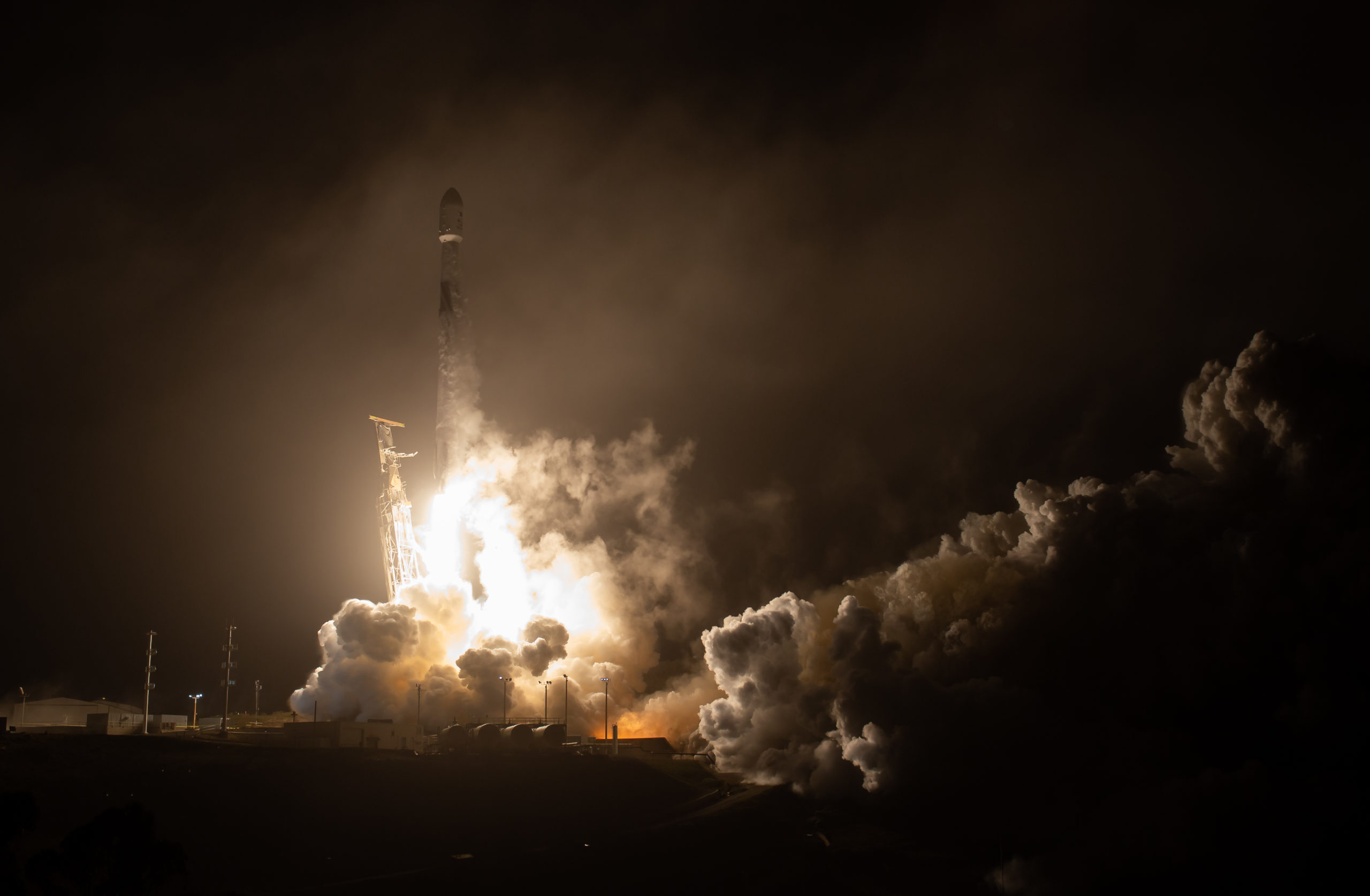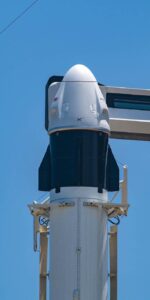
SpaceX has successfully flown its tenth mission of the year out of Vandenberg Space Force Base, Calif., following Saturday morning’s pre-dawn liftoff of a veteran Falcon 9 booster from a fog-enshrouded Space Launch Complex (SLC)-4E. Scrubbed yesterday at T-55 seconds—just after the rocket assumed primary control of countdown operations and entered its “startup” phase—the ten-times-flown B1063 speared uphill at 6:16 a.m. PDT, laden with five Iridium NEXT global mobile communications satellites and 16 advanced broadband satellites for London, England-based OneWeb.
It marked SpaceX’s fifth Falcon 9 launch of May, following on the coattails of four back-to-back Starlink missions—totaling 185 of these flat-packed internet communications satellites—from the East and West Coasts, inside the month’s first three weeks. And it forms the second of a planned weekend triple-header for SpaceX, following Friday’s just-past-midnight Starlink launch and Sunday evening’s targeted 5:37 p.m. EDT liftoff of Dragon Freedom and her four-person Ax-2 crew, bound for a ten-day research and educational outreach stay on the International Space Station (ISS).
In readiness for Sunday’s post-sunset launch from historic Pad 39A at Florida’s Kennedy Space Center (KSC), the brand-new B1080 Falcon 9 core, with the once-flown Freedom perched at her tip, was rolled from the Horizontal Integration Facility (HIF) to the pad late Thursday. Her Ax-2 crew—Commander Peggy Whitson, Pilot John Shoffner and Mission Specialists Ali Al-Qarni and Rayyanah Barnawi of Saudi Arabia—on Friday performed a Dry Dress Rehearsal (DDR) of their launch-day processes and procedures, donning their customized SpaceX launch and entry, riding their Tesla Model X cars out to the pad and boarding Freedom to familiarize themselves with the spacecraft.

Several hours after the DDR, with the Ax-2 crew back in their crew quarters, B1080 was put through a Static Fire Test of her nine Merlin 1D+ engines. This exercise is customary prior to the maiden voyage of any Falcon 9 and B1080 marks the third brand-new “single-stick” booster to have entered SpaceX’s ranks so far in 2023.
Weather remains the overarching concern, with a roughly 60-percent probability of acceptable conditions for Sunday’s opening launch attempt, deteriorating to only 20-percent-favorable for the backup opportunity at 5:14 p.m. EDT Monday 22nd and 30 percent if teams opt for a third date on Tuesday 23rd. At last week’s post-Flight Readiness Review (FRR) news conference, NASA leaders noted that Ax-2 is ideally aiming to fly either Sunday or Monday, but if it misses either date it would nominally stand down to make way for the high-priority CRS-28 Cargo Dragon research mission, scheduled to launch on 3 June.

Elsewhere, in readiness for B1063’s flight out of Vandenberg, the West Coast-based Autonomous Spaceport Drone Ship (ASDS), “Of Course I Still Love You”, departed Port of Long Beach last week. OCISLY took up position about 410 miles (660 kilometers) offshore in the Pacific Ocean to recover the booster at the end of her flight.
Following Friday’s scrubbed opening launch attempt just before 6:19 a.m. PDT, SpaceX declared that both vehicle and payload remained healthy, as teams pressed towards a backup opportunity at 6:16 a.m. PDT Saturday. Making her 11th uphill trek since November 2020, B1063 logged five launches last year alone and has now flown no fewer than three times inside 2023’s opening half.

Key payloads included NASA’s Sentinel-6 Michael Freilich and Double Asteroid Redirection Test (DART) missions, a grand total of 358 Starlinks and last month’s 51-payload Transporter-7 “rideshare”. B1063 becomes only the eighth booster since December 2021 to have completed more than ten flights.
Aboard this morning’s mission were five ground-spares for Iridium NEXT’s global mobile communications network and 16 OneWeb satellites. Early last month, the OneWeb payload—which consists of 15 Generation One satellites and a single Generation Two prototype, nicknamed “JoeySat”—departed its factory in Florida for the 2,721-mile (4,379-kilometer) cross-country road trip to California.

It is SpaceX’s fourth OneWeb launch, after three prior missions last December, January and March. Those flights safely delivered 120 Generation One satellites uphill, with today’s mission raising that number to 135.
Also nestled in the OneWeb stack was JoeySat, which carries a digitally regenerative payload and seeks to demonstrate multi-beam electronically steered phased array antennas. Developed through the Sunrise Partnership, and jointly funded by the European Space Agency (ESA) and the UK Space Agency (UKSA), JoeySat will test an innovative beam-hopping functionality—hence the association of its name with a joey—to enable future satellites to switch between different places on Earth and adjust the strength of signals based up on customers’ needs or demands.

Following an initial launch of six OneWeb test satellites aboard a Russian Soyuz rocket out of the Guiana Space Center in Kourou, French Guiana, back in February 2019, a further 12 flights between February 2020 and February of last year delivered a total of 422 operational satellites into orbit. Those missions originated variously from the Guiana Space Center, Kazakhstan’s famed Baikonur Cosmodrome and the Vostochny Cosmodrome in the Russian Far East.
That total represented about 66 percent of OneWeb’s planned first-generation network of 648 satellites. But following President Vladimir Putin’s February 2022 invasion of Ukraine, and a raft of economic sanctions imposed on Russia, OneWeb suspended six further launches out of Baikonur and sourced alternate providers. Last March, it contracted with SpaceX, then added New Space India Ltd.— commercial arm of the Indian Space Research Organisation (ISRO)—to its expanding launcher portfolio in April.

Seventy-two more OneWebs rode a pair of Indian Geosynchronous Satellite Launch Vehicle (GSLV) III boosters from the Satish Dhawan Space Centre in Sriharikota, Andhra Pradesh, in October 2022 and March of this year.. And three Falcon 9 missions last December, January and March lofted 120 OneWebs from the Space Coast, bringing the present total to 618, counting two satellites that failed on-orbit.
Prior to Saturday’s launch, that represents more than 95 percent of OneWeb’s 648-strong Generation One constellation. “We can currently provide global satellite coverage with the 618 craft already in orbit,” OneWeb tweeted, “but these extra satellites are set to be added to the constellation to provide extra resilience to our high-speed, low-latency network.”

And the five Iridium NEXT birds made this the ninth mission that SpaceX has flown for Iridium, following eight previous flights out of Vandenberg between January 2017 and January 2019. Those missions delivered 75 Iridium NEXT satellites to orbit.
“The spare satellites have no utility to us on the ground,” explained Iridium CEO Matt Desch, in remarks made last September. “We built extra satellites as an insurance policy and with SpaceX’s stellar track record, we look forward to another successful launch, which will position us even better to replicate the longevity of our first constellation.”

Following liftoff at 6:16 a.m. PDT, B1063 powered smoothly uphill for the opening 2.5 minutes of flight, before returning to a picture-perfect touchdown on OCISLY’s expansive deck. The Merlin 1D+ Vacuum engine of the Falcon 9’s second stage then came alive for a standard six-minute “burn” to deliver the Iridium NEXT/OneWeb payload towards their intended deployment orbit.
A little past 59 minutes into this morning’s mission, the first of the five Iridium NEXT birds was released into space, followed by the remainder at roughly one-minute intervals, with the entire quintet deployed by 64 minutes after launch. Next came the 16 OneWebs, which departed in pairs, beginning at 65 minutes and ending at 86 minutes into the flight, with JoeySat deployed a little past the 83-minute mark.






One Comment
One Ping
Pingback:SpaceX Aims to Launch Saudi Arabian Satellite Tonight - AmericaSpace